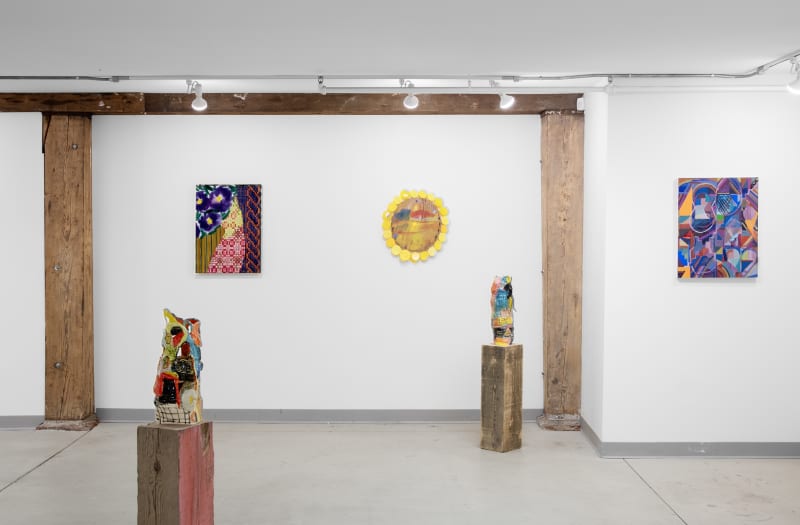For “Asters & Goldenrod,” the curators invited five New England artists to contribute work. They, in turn, invited peers with whom they carry on some form of creative dialogue. Another exchange, the symbiotic systems of nature, informs the show’s title. Asters and goldenrods often grow together, sharing the resources of their habitat, but also interacting in ways that enhance it. For instance, their paired growth increases biodiversity by attracting various pollinators that might not be drawn to one or the other plant on its own, and their root systems infiltrate different depths (asters’ shallow roots stabilize the soil, while goldenrods’ deeper roots help moisture retention and prevent erosion).
In this light, the aesthetic couplings become beautiful examples of our own interdependence and the human porosity that’s possible when we remain curious about each other instead of aligning ourselves with what differentiates us.
Take, for example, the exchange between Hannah Secord Wade and Richard Yu-Tang Lee. On the surface, they have little in common. Secord Wade’s work is representational and graphic, while Yu-Tang Lee’s is vaguely calligraphic, but fundamentally abstract. Secord Wade’s iconography of objects seems thrown together in incongruous, at times surreally off-putting ways, while Yu-Tang Lee’s are all movement and rhythm sans content.
Yet both artists share a similar palette, and viewing them together can approximate a process of disintegration or deconstruction, where solid objects in Secord Wade’s works (or, in a larger sense, what we interpret as fixed and categorizable “things”) dissolve into some less graspable essences of themselves in Yu-Tang Lee’s paintings. This serves both artists’ ends. Secord Wade’s work often deals with our futile attempts to control what we cannot control (striving to label, pigeonhole or otherwise rationalize ourselves into understanding things that are essentially mysterious). Yu-Tang Lee proposes a way of coming closer to that mystery by understanding the symbiotic relationship between opposites (fact versus perception, reality versus memory, etc.).
Similarly, Meghan Brady and Jackie Gendel share palettes, but also a fondness for creating a kind of compositional, yet abstract, architecture in their works. Brady does this more literally with what we could characterize as visual building blocks: geometric shapes, arabesque lines, collage-like layering. Gendel uses arches and step forms, grids and the occasional figure present within them. Both create space that feels at once contained and open.
Jennie Jieun Lee and Emily Noelle Lambert share a material affinity for ceramic, as well as a subversive way of using it pictorially, the former doing so in two dimensions, the latter in three. And on and on. It’s fun to decipher the similarities and differences between pairs of artists. But it’s also uplifting – and, I would argue, therapeutic in our dissonant, polarized now – to find peaceful coexistence and commonality amid dissimilarity and divergence.
[Excerpted from full review.]
